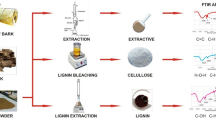Abstract
EXTRACTION of Acacia excelsa heartwood gave an imino-acid (0.2 per cent), m.p. 294° (decomp.), [α]D 20−13.4° (1 per cent in water), characterized by an N-benzoyl derivative, m.p. 172°, and identified as trans-4-hydroxypipecolic acid. The acid was later isolated from the wood of other Acacia species, and was more conveniently obtained from the fresh leaves of A. oswaldii (0.25 per cent yield). The imino-acid fraction, isolated by means of the N-nitroso derivatives1, sted alnsicomost entirely of proline, pipecolic acid, and the hydroxypipecolic acid, which crystallized readily from aqueous ethanol. The naturally occurring trans-isomer was epimerized by aqueous barium hydroxide (155°, 12 hr.) to a mixture of cis- and trans-4-hydroxypipecolic acid, and on paper chromatograms developed with butanol-acetic acid-water (4:1:5) the cis-acid (R F 0.17) was indistinguishable from an authentic specimen, but was clearly separated from cis-3-hydroxypipecolic acid (R F 0.24). A further distinction between the 3- and 4-hydroxypipecolic acids is that the former acid is decomposed when heated with alkali under conditions that cause epimerization of 4-hydroxypipecolic acid, and 3-hydroxypipecolic acid therefore resembles other β-hydroxy-α-amino-acids in its alkali-lability2. The naturally occurring trans-4-hydroxypipecolic acid ran in butanol-acetic acid-water with the same R F (0.21) as 5-hydroxypipecolic acid from dates1, but the two acids were separated on paper chromatograms developed with water-saturated phenol, and the 4-hydroxypipecolic acids were also distinguished by giving with ninhydrin a characteristic grey colour which showed deep red fluorescence under ultra-violet light.
Similar content being viewed by others
References
Cohen, L. A., Irreverre, F., Piez, K. A., Witkop, B., and Wolff, H. L., Science, 123, 842 (1956). Witkop, B., and Foltz, C. M., J. Amer. Chem. Soc., 79, 192 (1957).
Wieland, T., and Wirth, L., Ber. deutsch. chem. Ges., 82, 468 (1949). Wieland, T., Cords, H., and Keck, E., Chem. Ber., 87, 1312 (1954).
Virtanen, A., and Kari, S., Acta Chem. Scand., 9, 170 (1955).
Fowden, L., Biochem. J., 70, 629 (1958).
Author information
Authors and Affiliations
Rights and permissions
About this article
Cite this article
CLARK-LEWIS, J., MORTIMER, P. Occurrence of 4-Hydroxypipecolic Acid in Acacia Species. Nature 184, 1234–1235 (1959). https://doi.org/10.1038/1841234b0
Issue Date:
DOI: https://doi.org/10.1038/1841234b0
- Springer Nature Limited
This article is cited by
-
Chiral secondary amino acids, their importance, and methods of analysis
Amino Acids (2022)





